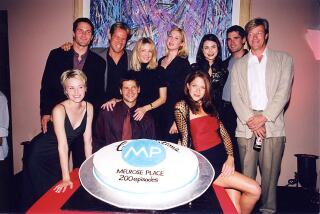‘Thirtysomething’ team reunites to reflect on revolutionary ABC drama
Some thirtysomething years after its premiere, the creators and some cast members of “thirtysomething” gathered Saturday for a mini-reunion.
Series creators Marshall Herskovitz and Edward Zwick and cast members Melanie Mayron, Timothy Busfield, Peter Horton, David Clennon and Polly Draper took part in a panel at the ATX Television Festival to discuss the influential series.
The yuppie drama, which premiered in 1987 and ran for four seasons on ABC, followed the lives of a group of Philadelphia baby boomers navigating the labyrinth of career, parenting and life dilemmas — a stark contrast to the programs that populated network schedules at the time.
“We just talked about what was happening in our lives,” Herskovitz said.
Added Zwick: “At the moment, there were only cops and lawyers and doctors, only franchise shows. [ABC] was in the toilet. They didn’t know what else to do, so they thought, we might as well try it.”
Though never a huge hit, the series had a lasting influence as a character-driven drama about ordinary life, paving the way for series such as “Brothers & Sisters” and, most recently, “This Is Us.”
“TV now, it’s such an art form,” said Draper, who played Ellyn Warren. “TV is a whole different thing than it was during our time. There was such a divide. It wasn’t written like a TV show. This bridged the gap [between film and TV] and changed the whole course of TV history.”
Herskovitz said he realized the show was connecting with audiences from the night of the premiere — recalling the show’s debut, which led into the nightly news where anchor Tawny Little was emotional.
“Her mascara [was] literally all the way down her cheeks, and she’s still sobbing and she’s like, ‘Oh, my God, was everyone watching that show?’ ” he recalled.
While today’s era of television heavily leans toward serialized storytelling, Herskovitz and Zwick said they made a conscious choice to approach “thirtysomething” as a “meditation upon a theme.” The drama tackled the everyday struggles of ordinary people in a way that “allowed us to do things that were deeper,” Zwick said.
But its goal of depicting real life was almost a little too real for the network. Early on in the first season, ABC had concerns the show was too dark, Zwick said, and requests were made to lighten things up. Marshall and Zwick, however, opted not to soften the storytelling.
The determination to present a portrait of real life led to the show’s being one of the first prime-time series to show gay men in bed together. The original script had the two characters kissing — but ABC’s director of standards and practices decreed that a kiss was not to be shown. Herskovitz fought for the on-screen kiss, until one of the actors in the scene, David Marshall Grant, made the case that the representation of two men in bed together was subversive and revolutionary on its own.
Zwick and Herskovitz say it was all in service of their mission from the start: to tell stories about intimate life between people.
“You have to keep out the giant dramas because they will drown out the things we wanted to talk about,” Herskovitz said.
Twitter: @villarrealy
More to Read
The complete guide to home viewing
Get Screen Gab for everything about the TV shows and streaming movies everyone’s talking about.
You may occasionally receive promotional content from the Los Angeles Times.





